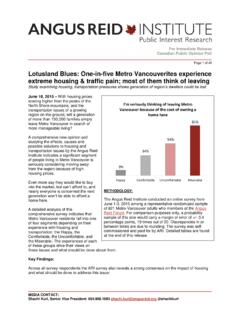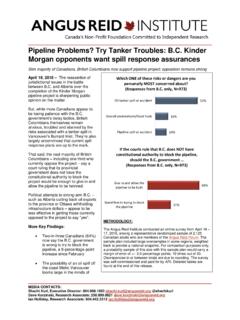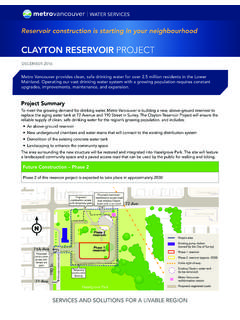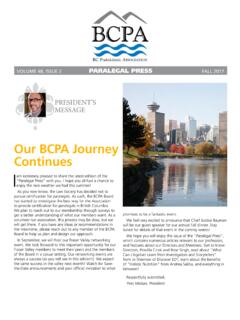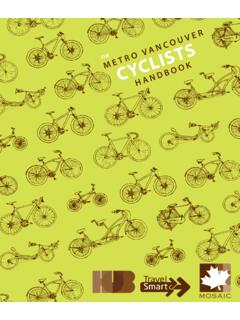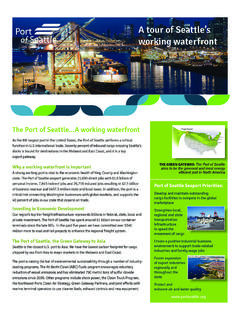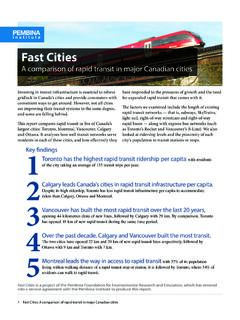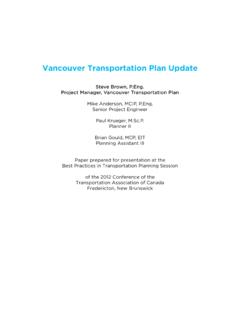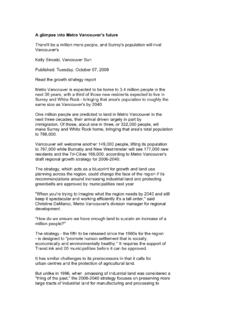Transcription of Towards the Circular Economy - Vancouver Economic …
1 Towards the Circular Economy : Identifying local and regional government policies for developing a Circular Economy in the fashion and textiles sector in Vancouver , CanadaResearch completed by Andrea De Paoli, September 2015 EXECUTIVE SUMMARY What local and regional policies should be implemented to catalyze a Circular Economy in the fashion and textile industry in Vancouver , Canada? Government policy and regulations provide the enabling framework for the Circular Economy to flourish. However, there is no standardized approach to creating a Circular Economy ; instead, policies must be appropriate for the local influential Vancouver businesses were engaged in May and June of 2015 to help define the context, barriers, and local policy needs for stimulating the shift to a Circular Economy in Vancouver s fashion and textiles sector.
2 Overall, the context for creating a Circular Economy in the fashion and textile sector in Vancouver is positive businesses are already striving to reduce waste and are interested in moving Towards circularity. That said, the drivers to move toward Circular Economy business models are not strong enough for businesses to pursue this change on their own. Businesses in Vancouver believe that government can play a vital role in providing the policy levers and incentives for change that will encourage the shift to a Circular Economy . The local and regional governments can catalyze the shift to a Circular Economy in Vancouver s fashion and textiles sector through: 1. Implementing an Extended Producer Responsibility (EPR) standard for textiles 2. Implementing a waste ban for textiles3. Encouraging research and development for textile recycling4.
3 Manage or facilitate textile collection programs 5. Providing and encouraging the uptake of recycling infrastructure6. Building education and awareness about textile waste 7. Implementing pilot take-back programs 8. Educating fashion designers about the full lifecycle impacts of clothing 9. Providing financial incentives and green credits for local businesses that reduce waste and are sustainable 10. Enabling local manufacturing and encourage regional material loops* Businesses identified EPR as the most important and effective policy to develop a Circular Economy in the the past decade, generating a Circular Economy has become a priority for both businesses and cities wishing to move Towards sustainability. A Circular Economy offers an alternative model to our take-make-waste model of consumption by keeping materials in circulation (and out of the landfill).
4 While businesses primarily have been the focus of Circular Economy initiatives, cities have been identified as the ideal location for creating closed, regional material In the city of Vancouver , Canada, local governments and a number of fashion and textile businesses recognise the opportunities that come from moving toward a Circular Economy . For one, the Circular Economy offers a solution to the growing problem of textile waste, which currently amounts to over 30,000 tonnes added to metro Vancouver landfills each In addition, the Circular Economy offers an opportunity to generate Economic growth, increase the number of local green jobs, and contribute to the City s goal to be the greenest city in the world by For local fashion and textile businesses, the Circular Economy provides an opportunity to create new profit streams, increase their resilience to volatile input costs, and 1 Ellen MacArthur Foundation, 20132 metro Vancouver Solid Waste Dept.
5 , 20143 Ellen MacArthur Foundation, 2015; Lee et al, 2013support their efforts to become completely sustainable and socially responsible4. That said, a number of barriers will need to be overcome in order for the Circular Economy in the fashion and textile sector to become a reality. Government policy will play a critical role in addressing these barriers and creating opportunities to guide the shift to circularity5. Indeed, there are many promising examples of the types of policies that regional and local governments can, or have, implemented around the globe to spur the shift to a Circular Economy . Although there is no standardized approach to creating a Circular Economy , there are many creative solutions being explored. This paper outlines the role Vancouver s local and regional governments can play to help catalyze a Circular Economy in the fashion and textile sector in Vancouver .
6 While policy alone won t drive the development of the Circular Economy , this paper outlines the context for creating a Circular Economy in Vancouver , identifying the barriers that will need to be addressed and the key action areas in which government can play a Ellen MacArthur Foundation, 20135 Ellen MacArthur Foundation, 2015 CONTENTSThe Global Textile Industry .. 3 Policy as a Driver of the Circular Economy .. 5 Research Context + Methodology .. 8 Research Findings: Drivers + Barriers .. 11 Research Findings: Policy Recommendations .. 16 Summary of Key Findings .. 21 Appendices + References .. 222 The limits of our take-make-waste model of consumption are extremely apparent when examining the textile industry. As the global population and the middle class continue to grow, so too does the demand for textiles, which has steadily increased since the Likewise, global fibre production also continues to set new records.
7 In fact, global production of cotton and polyester, the two main fibres in the textile industry, is expected to grow by 40% in the next 5 Much of the increase in textile consumption has been attributed to industry changes which have emerged since textile and clothing production has moved to developing countries, mainly in Asia, where they can be produced cheaply and quickly, driving down costs and ultimately increasing While this is true for many soft goods, including footwear, clothing and carpets; nowhere is this more apparent than with the emergence of the fast fashion industry, where cheap clothing brands are designed to sell new styles every two weeks according to regularly changing While cheap clothing can make fashion more accessible across the globe, many consumers tend to purchase more than they need and have developed a throwaway attitude as a In fact, a number of studies have confirmed that most consumers throw textiles away, even if the consumer is interested in protecting the 1 Elkstrom and Salomonson, 2014; Hvass, 2014; Kalmykova et al.
8 20152 Circle Economy (a), 20153 Niinimaki and Hassi, 20114 Cataldi et al, 2012; Niinmaki and Hassi, 20115 Cataldi et al, 20126 Birwistle and Moore, 2007; Joung, 2014 THE GLOBAL TEXTILE INDUSTRYOur linear model of consumption of textiles cannot be sustained. Textile waste is now estimated to be the fastest growing waste stream in many In the UK, Netherlands, and Nordic countries, 61% of textile waste is landfilled or incinerated after only one use; only 39% is re-used or In the US, textiles have one of the poorest recycling rates of reusable materials. Americans only donate 15% of their clothing for recycling or reuse9 and often textiles that are re-used or repurposed only remain useful for one additional impact of this waste goes beyond the landfills as textile production also creates a significant amount of waste.
9 Cotton farming is characterized by intensive agriculture, which uses large amounts of irrigation and During production, energy waste and toxic water pollution are And at end of life, synthetic fibres do not decompose; while materials that do decompose produce methane Moreover, textile production relies on finite resources that will only become scarcer as demand continues to increase: cotton and other natural fibres require significant agriculture landmass and polyester requires finite supplies of As population growth and climate change put pressure on these scare resources, sustainability will become a strategic business imperative for textiles businesses. 7 Niinimaki and Hassi, 20118 Circle Economy (a), 20159 Cline, 201410 Circle Economy (a), 201511 Niinimaki and Hassi, 201112 Ashby et al, 2012; Cataldi et al, 2012; Elkstrom and Salomonson, 201413 Morgan and Birtwistle, 200914 Circle Economy (a), 2015; Christiansen et al, 20133A Circular Economy for textiles.
10 The Circular Economy offers a sustainable alternative to the linear model of consumption characterized by the textile industry. The Circular Economy model operates within planetary boundaries where resource loops are closed, waste-free and resilient by Economic activities are geared Towards keeping materials infinitely in circulation through waste avoidance, material efficiency and resource The Circular Economy goes beyond recycling to focus on waste prevention and reduction first, by reusing, repairing, reselling or redistributing materials. If that is not possible, materials are recycled and recovered from the waste stream and used as inputs, substituting the demand for virgin resources. Finally, waste prevention may be achieved by designing, producing and consuming products in a manner that prevents waste in the first place, so that people and systems downstream don t have to manage In addition, all energy in a Circular Economy is derived from renewable and sustainable Circular textiles industry, therefore, would see textile products, fabrics and fibres continually cycled through connected loops within and across Products would be designed with cyclability and quality in mind, which may require the use of different materials (for example, sustainable and recyclable fabrics such as hemp and bamboo) and designing out waste in the first place (by using fabrics that are of high quality, are more resistant to wear, and can be repaired).
